Protests over the death of George Floyd have culminated in some of the largest civil rights uprisings in history. And white, wealthy areas like Santa Monica are no longer exempt.
Brianna SacksBuzzFeed News Reporter
Posted on June 5, 2020
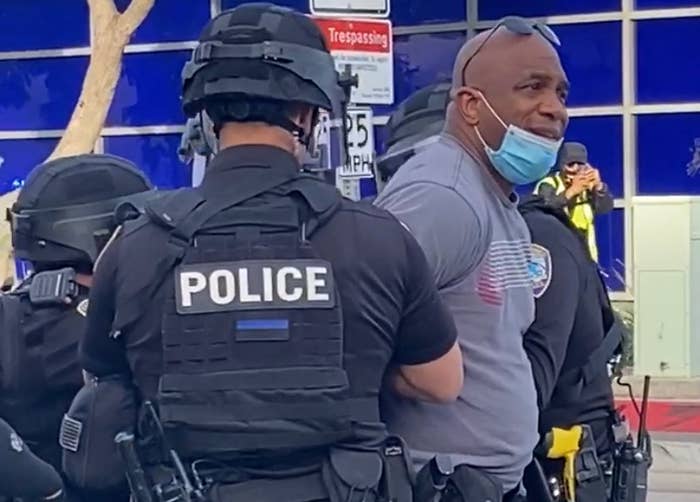
Brianna Sacks / BuzzFeed News
David Brown had been demonstrating peacefully, along with a group of other protesters near the Third Street Promenade in Santa Monica when he felt hands latch onto him. Police officers roughly pulled him out of the crowd. They pushed him — hard. They prodded him with their batons. Then they clapped cold steel handcuffs around his wrists and took him into custody.
“They put me in a van and they slammed those doors,” he said, “and I never heard such a deafening sound as when they closed those doors.”
Hours later, police dropped him off at a gas station on Centinela Avenue, at the Los Angeles city limits. If you go back to Santa Monica, he said they told him, you will be arrested.
“What do you mean ‘don’t go back’?” he said he asked the officers. “I live in Santa Monica.”
Brown, who is Black and has lived in the beach town since high school, had been out on the street because he wanted to witness the movement against police brutality that has swept the country since the killing of George Floyd.
At 59, he is old enough to remember the Rodney King uprising of 1992, when he watched on television as Los Angeles’s historically Black neighborhoods like Crenshaw and Watts went up in flames. This time was different — in Los Angeles at least. This time, he said, protesters got smart and decided: “‘You know what, we’re going to the white neighborhoods and tear up their neighborhoods. We’re going to Bloomingdales, Beverly Hills, the Grove, all those places,’ and that’s exactly what they did.”
It was a deliberate strategy, according to Black Lives Matter LA cofounder Melina Abdullah. In 2013, during a protest over the killing of Trayvon Martin and the acquittal of his killer, George Zimmerman, the group decided to march in Beverly Hills, so that LA’s rich, white residents could not turn away. The tactic worked and, Abdullah said, has since been adopted nationwide.
“We are not willing to enable white folks with wealth to retreat to their places of refuge,” she said.
Which is what brought protesters on Sunday to Santa Monica, a city whose leafy streets are lined with multi-million dollar homes. The protest began on a street near the beach and was mostly peaceful, but a few blocks away, separate groups came in and targeted the heart of a popular shopping area — looting and vandalizing dozens of stores and starting fires. Police moved in and arrested more than 400 people, including some peaceful demonstrators. Authorities later said more than 95% of those arrested did not live in the city.
The destruction and violent clashes in Santa Monica played on televisions across the world. There were scenes of looting and burning, and images of police brutalizing demonstrators, blasting them at close range with rubber bullets.
“Normally, we are able to anticipate when a dispersal order is coming,” Abdullah said. “It’s all out the window this time. Police aren't giving people a chance to decide. They're beating people with batons. Several members were beaten to the point of hospitalization, and that's new for us.”
For some residents of Santa Monica’s historically Black and Latinx neighborhood who participated in the demonstrations, the events in their city felt both surreal and empowering.
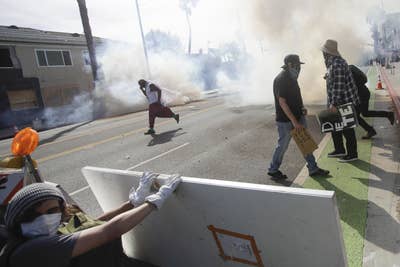
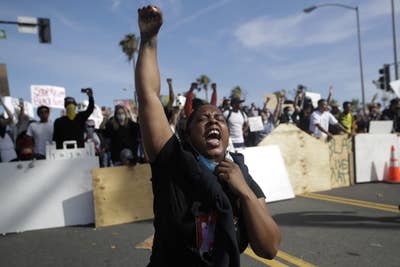
Marcio Jose Sanchez / AP
“Everything that is so shiny about Santa Monica is now being destroyed in front of everyone’s eyes,” said Jessica Walker, a Santa Monica High School graduate who is now pursuing a master’s degree in child development. She stood in an alley near the promenade that was littered with shoeboxes and water from a broken main as looters spilled out of a shattered store window.
“It’s a rude awakening for Santa Monica natives,” she said, adding that, “with all the pain and suffering Black people have gone through, the looting and damage doesn’t compare.”
For Brown, though the violence across the city, and his own rough detainment, has been painful and complex to process, he said he also felt "more connected to some of his white neighbors."
At 6 feet and 230 pounds, he’s used to being singled out and discriminated against — used to getting pulled over in Beverly Hills because his friend was driving a BMW and having men move closer to their girlfriends when he walks toward them down the street. He makes a concerted effort to fit in and dress clean and crisp, in polos and cargo shorts, and wears a suit and tie to work.
But now, he said he’s “talking to more white people than I have never talked to before. I am seeing a lot of white people out there and it feels like we are more on a common ground. The fact that we can talk, and we can walk together and talk together like we've known each other for a long time. That wouldn't have happened before.”
He was relieved that, this time, it wasn’t South Los Angeles that burned, as it did in 1992 and before that in 1965. Some neighborhoods in South LA still haven’t been completely rebuilt, he knew, whereas the damage in Santa Monica would likely be repaired almost immediately.
At the same time, it hurt to see his city “ruined” because people felt desperate, angry, vengeful, empowered — or were simply opportunists seizing on a moment that burst in the middle of a global pandemic, and its accompanying dire economic situation and historic unemployment rate, to loot succulents from West Elm. He gets it, though. He mostly lives paycheck to paycheck, and he doesn’t know how much more he can take. His income as a Lyft driver has plummeted during the pandemic, and he’s still waiting for his stimulus check and unemployment money to arrive.
Brown has lived in the same rent-stabilized two-bedroom in Santa Monica for most of his life. In 1978, when he was 17 years old, his mom moved him and his two older brothers from Chicago to the then-sleepy beach town.
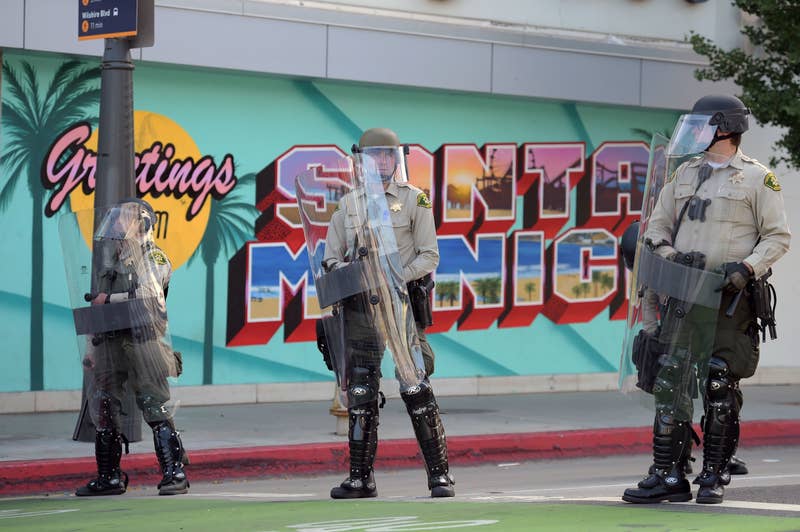
Agustin Paullier / Getty Images
“She fell in love with it after one vacation,” Brown said of his late mother.
Santa Monica’s Pico neighborhood straddles the 10 Freeway at the city’s southern end, near the airport. The neighborhood used to be predominantly Black and Latino, and still has more diversity than the rest of the city. It is also much less wealthy and historically has had more problems with gang violence. Between 1980 and 2013, almost half of Santa Monica’s homicides occurred within those blocks.
Still, the area is changing, squeezed by the gentrification that has swept across Los Angeles and especially along the beach.
“It’s a stark contrast here in just 10 years,” said Oscar de la Torre, a longtime community activist and founder of the Pico Youth & Family Center. “The changes have escalated to a whole new level, and there’s a lot of displacement.”
De la Torre, who also grew up in the Pico area, recalls the rarity of seeing a white person walking down the street in the 1980s and parents cautioning kids not to ride their bikes north of Wilshire Boulevard, because police would “pull you over and ask what you were doing.” As Santa Monica grew, city leaders put all the “undesirable shit,” like the city dump, bus yards, buildings, and infrastructure within that rectangular district. When the crack cocaine epidemic hit, gang violence also spiked.
While it’s gotten better over the years, de la Torre noted that there’s still palpable racism in Santa Monica. There are no Black members on the city council, and the area’s minorities have been eradicated as developers purchase plots and erect multimillion-dollar condos next to rent-stabilized buildings like Brown’s, where mostly Latinx or Black families are still able to live because landlords are limited in how much they can raise the rent.
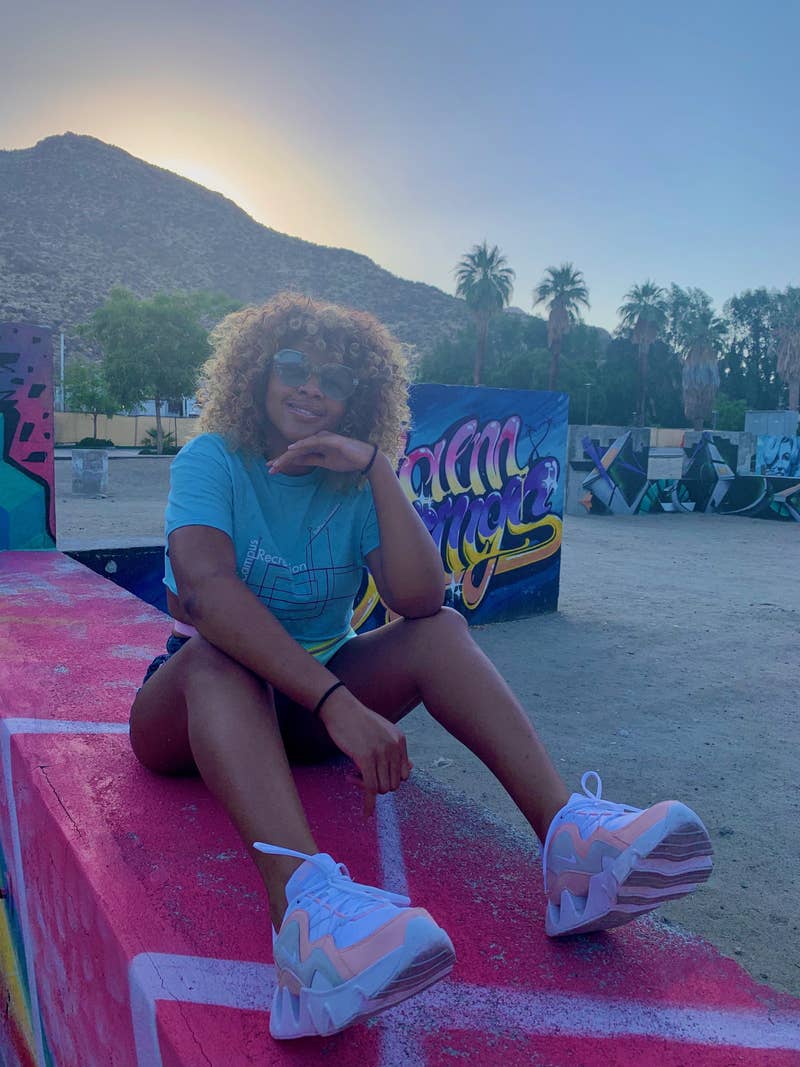
Samantha Borges
Jessica Walker
Jessica Walker also grew up in the Pico neighborhood, in a rent-stabilized building that’s now sandwiched between brand-new developments filled with mostly white tenants, she said. When she was 16, students at her high school hung a noose around a dummy and chained one of her other Black wrestling teammates to his locker and chanted “slave for sale.” After that, she helped create the Committee for Racial Justice at Santa Monica High School, organized events against racism, and spoke out at school board meetings.
Essentially, she said, she’s spent a lot of her life speaking out against racism and the killing of Black people by police. Until now, she said, she felt like it often has been ignored. That was until people brought their anger and exhaustion to white people’s doorsteps and burned them down. After Santa Monica’s demonstration on Sunday, she plans to attend another protest in Palm Springs on Saturday and is planning yet another one in Palm Springs on Monday. She’s also thinking about next steps: “How are we going to build our Black communities back up? How are we going to reform the justice system?”
“Now shit has really hit the fan, and now everyone is being forced to say something,” she said. “Santa Monica was a boiling point and white people are beginning to see it, especially through these most recent events.”
Nearly 30 years after he watched South LA rise up and evolve into a war zone from his mom’s living room, Brown scrolls through his recent uploads on Facebook, trying to process his own footage of burning restaurants, police firing tear gas in his streets, National Guard vehicles rolling by.
He said he doesn’t know how to feel: “I am electrified and numb.” A few days later, he saw a clip of his own arrest for the first time, and he finally cried. He’s going back out tomorrow.
No comments:
Post a Comment